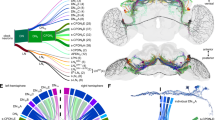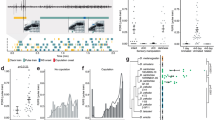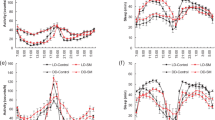Abstract
The Drosophila melanogaster male produces a species-specific courtship song by wing vibration. The most conspicuous feature of the song is a series of pulses with a 30–40-ms interpulse interval (IPI)1,2 which oscillate in wild-type males with a period of 50–60 s (ref. 3). This short-term biological rhythm in IPI is influenced by several gene mutations at the period (per) locus, which alter the normal 24-h free-running period of the circadian clock4 and have corresponding effects on the song cycle3. The present study reveals that, under restrictive conditions, temperature-sensitive mutations which affect neuronal membrane excitability seem to stop the biological clock underlying the fruitfly's song rhythm.
This is a preview of subscription content, access via your institution
Access options
Subscribe to this journal
Receive 51 print issues and online access
199,00 € per year
only 3,90 € per issue
Buy this article
- Purchase on SpringerLink
- Instant access to full article PDF
Prices may be subject to local taxes which are calculated during checkout
Similar content being viewed by others
References
Ewing, A. W. & Bennett-Clark, H. C. Behaviour 31, 287–301 (1968).
von Schilcher, F. Anim. Behav. 24, 18–26 (1976).
Kyriacou, C. P. & Hall, J. C. Proc. natn. Acad. Sci. U.S.A. 77, 6729–6733 (1980).
Konopka, R. & Benzer, S. Proc. natn. Acad. Sci. U.S.A. 68, 2112–2116 (1971).
Wu, C. F., Ganetsky, B., Jan, L. Y., Jan, Y. N. & Benzer, S. Proc. natn. Acad. Sci. U.S.A. 75, 4047–4051 (1978).
Suzuki, D. T., Grigliatti, T. & Williamson, R. Proc. natn. Acad. Sci. U.S.A. 68, 890–893 (1971).
Wu, C. F. & Ganetzky, B. Nature 28, 814–816 (1980).
Kimura, J. E. & Meves, H. J. Physiol., Lond. 289, 479–500 (1979).
Sevcik, C. J. Physiol., Lond. 352, 187–194 (1982).
Fuzeau-Braesch, S. & Nicholas, N. Comp. Biochem. Physiol. 68 A, 289–297 (1981).
Clark, M. A. & Eaton, D. C. J. Neurobiol. 14, 237–250 (1983).
Pittendrigh, C. S. Proc. natn. Acad. Sci. U.S.A. 40, 1018–1029 (1954).
Saunders, D. S. Insect Clocks 2nd edn (Pergamon, Oxford, 1982).
Takahashi, J. S. & Zatz, M. Science 217, 1104–1111 (1982).
Jackson, F. R., Wilson, S. D., Strichartz, G. R. & Hall, L. M. Nature 308, 189–191 (1984).
Kauvar, L. M. Molec. gen. Genet. 187, 172–173 (1982).
Hall, L. M., Wilson, S. D., Gischier, J., Martinez, N. & Strichartz, G. R. Ciba Fdn Symp. 88, 207–220 (1982).
Eskin, A. & Corrent, G. J. comp. Physiol. 117, 1–21 (1977).
Eskin, A. J. Neurobiol. 13, 241–249 (1981).
Eskin, A. J. Neurobiol. 8, 273–299 (1977).
Hall, J. C. in Results and Problems in Cell Differentiation Vol. 9 (ed. Gehring, W. J.) (Springer, Berlin, 1978).
Konopka, R., Wells, S. & Lee, T. Molec. gen. Genet. 190, 284–288 (1983).
Author information
Authors and Affiliations
Rights and permissions
About this article
Cite this article
Kyriacou, C., Hall, J. Action potential mutations stop a biological clock in Drosophila. Nature 314, 171–173 (1985). https://doi.org/10.1038/314171a0
Received:
Accepted:
Issue Date:
DOI: https://doi.org/10.1038/314171a0
This article is cited by
-
Female song preference and theperiod gene inDrosophila
Behavior Genetics (1993)
-
Drosophila courtship song cycles in normal andperiod mutant males revisited
Behavior Genetics (1990)
-
The molecular ethology of theperiod gene inDrosophila
Behavior Genetics (1990)
-
Spectral analysis ofDrosophila courtship songs:D. melanogaster, D. simulans, and their interspecific hybrid
Behavior Genetics (1988)



